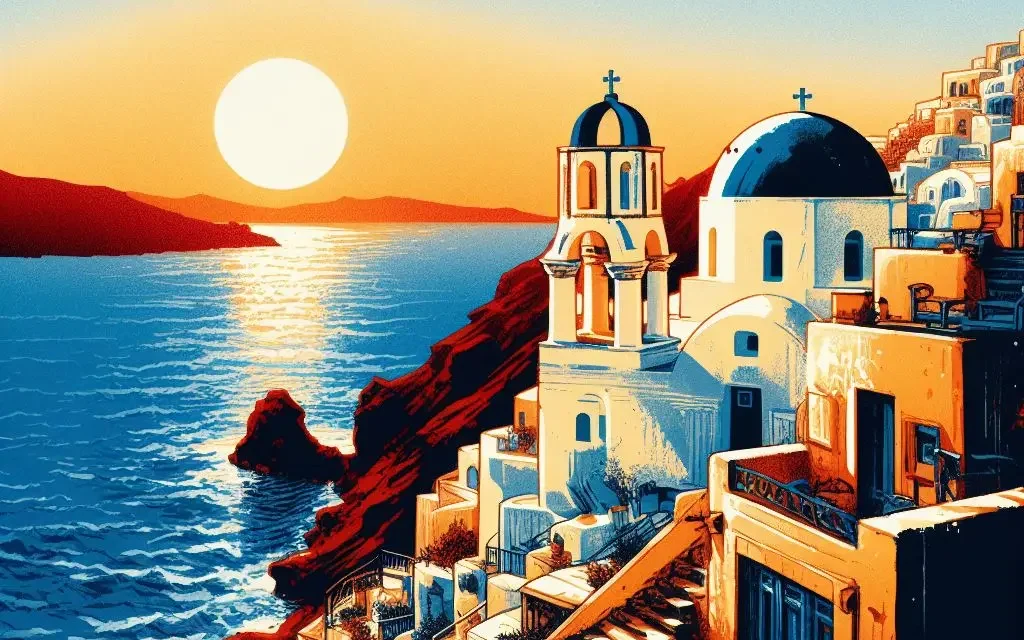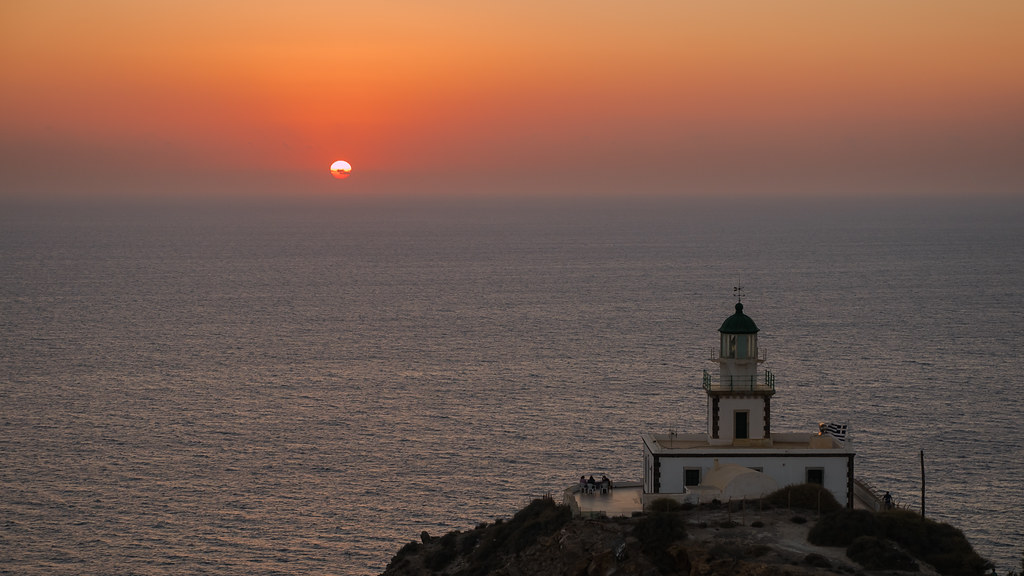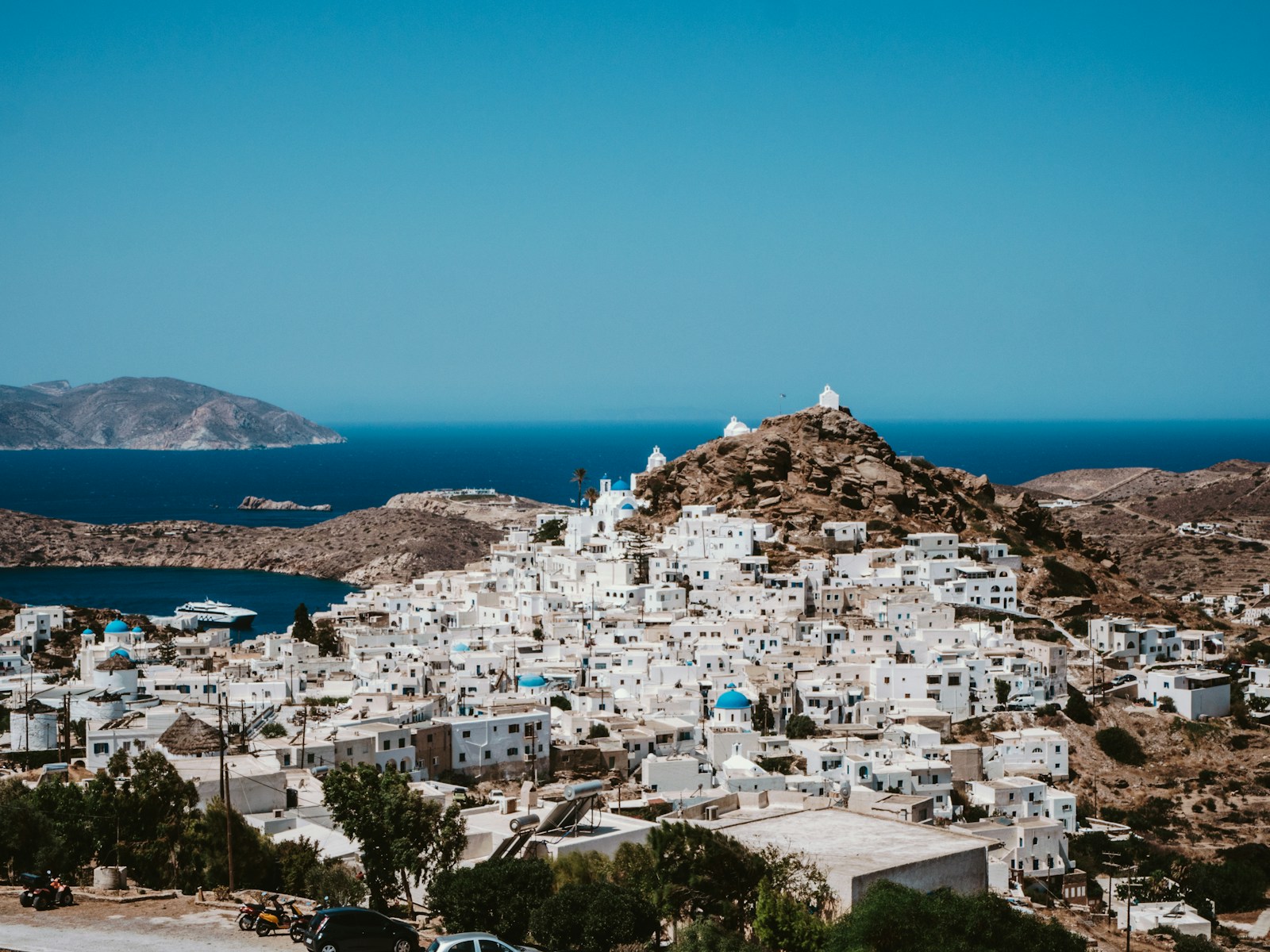Immersed in the cobalt waters of the Aegean Sea lies Santorini, a jewel of Greece celebrated for its awe-inspiring panoramas, quintessentially Greek white-washed houses, and iconic blue-domed churches. But beyond its postcard-perfect scenery, Santorini harbors a rich religious heritage and cultural fabric. This raises intriguing questions – how did Santorini emerge as a bastion of the Greek Orthodox Church? What ancient myths and legends have woven the island’s unique identity? And alongside the prevalent faith, what are the minority religions and cultural influences that contribute to the island’s rich mosaic?
In unfolding the narrative of Santorini’s spiritual journey, this article delves into the island’s religious tapestry, tracing its origins from the ancient times to the present-day mosaic of beliefs. We’ll discover how Santorini’s spirituality is intertwined with its topography, epochs, and the very essence of its people. Along the way, we’ll spotlight some of the most revered religious landmarks that you can experience on your visit. Whether you’re a committed devotee, an inquisitive wanderer, or a connoisseur of culture, this concise exploration provides an enriching glimpse into the heart of Santorini’s religious life.
The Dominance of the Greek Orthodox Church
The Greek Orthodox Church stands as the predominant faith in both Santorini and across Greece, with approximately 98% of residents identifying as Orthodox Christians. This church boasts a historic legacy originating from Byzantine times when Christianity was declared the official religion of the Roman Empire. Despite facing multiple invasions and persecutions, the church has steadfastly preserved its rich traditions and doctrines throughout the ages.
The Architecture of Faith: Iconic Blue Domes
On the Santorinian landscape, the iconic blue-domed churches are an unmistakable sight. These structures serve as much more than mere places of worship—they are emblematic of the island’s cultural essence and collective identity. Many are perched on the caldera rim, providing breathtaking vistas of the surrounding sea and the volcano. The dome’s striking blue hue mirrors the expansive sky and vast sea, whereas the pristine white walls represent purity and simplicity. Typically, these churches feature a modest, single-nave design complemented by a bell tower. The interiors are adorned with religious iconography, frescoes, and flickering candles. Among the most acclaimed are the Three Bells of Fira, the Cathedral Church of Candlemas of the Lord, and the 3 Dome Church in Oia.
Traditional Practices and Celebrations
The Greek Orthodox Church is renowned for its vibrant liturgical calendar, filled with a multitude of feasts and celebrations year-round. Key highlights include Easter, Christmas, and the Dormition of the Virgin Mary. During these holy days, churches become hubs of activity with congregations participating in services, lighting candles, and partaking in the holy communion. The revelry is heightened with processions, dazzling fireworks, music, and traditional dancing. Local patron saints, revered as guardians over their communities and villages, are celebrated with great fanfare. Each church dedicates a day to its patron saint, replete with a procession of the saint’s icon, sumptuous communal meals, and entertainment. Prominent among these are the celebrations of Saint John the Baptist, Saint Catherine, and Saint Nicholas.
Ancient Roots: The Mythology of Santorini
Santorini captivates with its mythological origins, tied to the heroic Argonauts and the mighty sea god, Poseidon. Legend has it that Santorini emerged from the sea as a clod of earth flung by Poseidon’s son, Euphemus, after he dreamt of a bewitching nymph, Triton’s daughter. This nymph became the mother of Theras, who would establish a settlement on the island and bestow upon it his name. Some experts believe this legend mirrors Santorini’s birth through a monumental volcanic eruption, rising majestically from the Aegean Sea.
From Pagan Temples to Christian Churches
In the time before Christianity took hold, Santorini was a vibrant hub for the worship of ancient gods and goddesses, particularly those associated with the sea and the underworld. Sacred temples abound, dedicated to deities like Poseidon, Apollo, Artemis, Athena, and Asclepius. Among these, the temple of Artemidoros on the islet of Thirasia stood out, housing statues of various gods. The 4th century AD marked a religious transformation as Santorini joined the Byzantine Empire, leading to the eradication or repurposing of pagan temples into churches and the erection of new sanctuaries honoring saints and the Virgin Mary. Santorini’s spiritual aura was further enhanced by the flourish of monastic life, with monasteries and convents dotting its dramatic landscapes.
The Blend of Religion and Tourism
In modern times, Santorini beckons as a popular tourist haven, with its religious history attracting countless visitors. They come to explore sites steeped in ancient and medieval lore, such as the archaeological treasures of Ancient Thera, the temples of Apollo and Artemis, and the breath-taking Monastery of Prophet Elias that offers a panoramic vista. The Museum of Prehistoric Thera provides a fascinating window into the Minoan civilization that once flourished here. The island’s religious spirit is vibrant, celebrated through festivals and events such as the Feast of the Dormition of the Virgin Mary, the Feast of Saint John the Baptist, and the Feast of Saint Catherine, which honor Santorini’s patron saints and rich traditions.
Minority Religions and Cultural Influences
The dominant religion is the Greek Orthodox Church, but Santorini’s religious tapestry is more diverse than it first appears. This section delves into the variety of religious groups and the cultural influences that complement the island’s rich Orthodox heritage.
Catholic and Other Christian Denominations
Santorini’s vibrant Catholic community, mainly centered in the town of Fira, maintains a quaint Catholic quarter. One of the cultural landmarks, the Catholic Cathedral, erected in the 17th century, features an eye-catching palette of blue, white, and peach. This historical edifice is not just a place of beauty but also serves as a venue for regular services and festivities. In addition to the Cathedral, the island boasts other Catholic places of worship, including the church of Saint John the Baptist in Akrotiri and that of Saint Catherine in Fira. The Catholic faithful observe their traditional celebrations, including Easter, Christmas, and the Assumption of the Virgin Mary on August 15th.
Apart from the Catholic believers, Santorini is home to others, including Protestants, Anglicans, and Jehovah’s Witnesses. These smaller communities enrich the island’s religious landscape with their presence, places of worship, and various activities. For instance, there’s an Anglican church in Fira, dating back to 1824, which opens its doors to believers of all denominations. Moreover, a Protestant church in Kamari offers bilingual services in English and Greek.
Cultural Celebrations and Interfaith Dialogues
Santorini’s allure extends beyond its spiritual life to cultural celebrations that draw international attention. Notable events include the Ifestia Festival, with its dramatic reenactment of the island’s volcanic activities through fireworks and artistic performances, and the International Music Festival, which sees a gathering of prodigious talent from the global music stage.
The island is also a bastion for interfaith dialogue and cooperation, a place where diverse faiths coexist with mutual respect and understanding. Notably, in 2023, Pope Francis landed on the shores of Santorini for a memorable visit. Meeting with the Orthodox Metropolitan, the Catholic Bishop, and other religious dignitaries, the Pope extolled Santorini’s culture of dialogue and harmony, urging the community to uphold the values of peace and solidarity.
Conclusion
Santorini, an island of unmatched beauty, boasts a religious tapestry as rich and varied as its history. Throughout this article, we’ve delved into the significant presence of the Greek Orthodox Church, unearthed the island’s mythological ancestry, and highlighted the varied minority religions and cultural strands that gracefully intertwine with the Orthodox tradition. Moreover, we’ve showcased some of the island’s most iconic religious landmarks and vibrant festivals, all ready to enhance your visit to Santorini.
We sincerely hope that our insights have provided you with a glimpse into the religious soul of Santorini, sparking curiosity to delve deeper into its historical and cultural essence. If you seek a journey enriched by spiritual significance, cultural depth, or the simple pleasure of picturesque explorations, Santorini promises a treasure trove of experiences. So why wait? Book your journey now and immerse yourself in the spiritual splendor that Santorini has to offer!
FAQ
What are the beliefs of Santería?
Santería, also known as La Regla Lucumí, is a religion with its roots in the Yoruba culture of West Africa, brought to the Caribbean by enslaved Africans. It blends elements from their traditional African beliefs with aspects of Roman Catholicism. Santería followers believe in one supreme god, Olodumare, alongside a pantheon of lesser deities or saints known as Orishas, each with its domain, personality, and rituals.
How does Santería differ from Christianity?
While Santería shares some similarities with Christianity, such as the recognition of a single, omnipotent god and the adaptation of Catholic saints, it diverges significantly in practice and theology. Santería retains a polytheistic system through the worship of Orishas, reflecting African traditions. Moreover, Santería rituals often involve offerings, divination, and possession, which are not typically found in Christianity.
What does practicing Santería mean?
Practicing Santería involves a commitment to the veneration of Orishas, which includes offering ceremonial gifts, participating in rituals, and adhering to specific dietary restrictions or behaviors as signs of respect and devotion. It is a way of life that encompasses spiritual growth, community involvement, and a connection to ancestral heritage.
What is the Afro-Cuban religion?
The term “Afro-Cuban religion” encompasses various belief systems in Cuba that originate from African traditions, including Santería. These religions reflect the syncretism between African spirituality and Christianity, predominantly Catholicism, which occurred due to the transatlantic slave trade. They share a common thread of reverence for natural elements and ancestors, as well as the practice of ritual and music in their worship.


